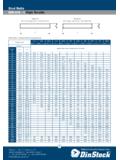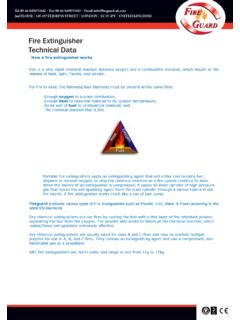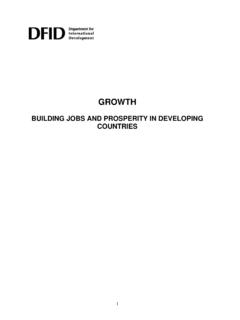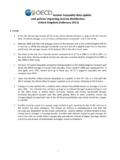Transcription of Burden of Disease from Environmental Noise …
1 Burden of Disease from Environmental NoiseThe health impacts of Environmental Noise are a growingconcern among both the general public and policy-mak-ers in Europe. This publication provides technical supportto policy-makers and their advisers in the quantitative riskassessment of Environmental Noise , using evidence anddata available in Europe. It contains the summary of syn-thesized reviews of evidence on the relationship betweenenvironmental Noise and specific health effects, includingcardiovascular Disease , cognitive impairment, sleep dis-turbance, tinnitus, and annoyance. For each outcome, theenvironmental Burden of Disease methodology, based onexposure response relationship, exposure distribution,background prevalence of Disease and disability weightsof the outcome, is applied to calculate the Burden of dis-ease in terms of disability-adjusted life-years. The resultsindicate that at least one million healthy life years are lostevery year from traffic-related Noise in the western partof Europe.
2 Owing to a lack of exposure data in south-eastEurope and the newly independent states, it was not pos-sible to estimate the Disease Burden in the whole of theWHO European Region. The procedure of estimating bur-dens presented in this publication can be used by inter-national, national and local authorities in prioritizing andplanning Environmental and public health policies. % %% %%%, +/&% %%%%% World Health Organization Regional Office for Europe Scherfigsvej 8, DK-2100 Copenhagen , Denmark Tel.: +45 39 17 17 17. Fax: +45 39 17 18 18. E-mail: Web site: Burden of Disease from Environmental noiseQuantification of healthy life years lost in EuropeBurden of Disease from Environmental noiseBuchdeckel:Layout 1 13:39 Seite 1 BurdenofdiseasefromenvironmentalnoiseQua ntification of healthy life years lost in EuropeWHO_Kim_Rokho_2011_14:Layout 1 13:43 Uhr Seite iKeywordsNOISE advErSE EffEctSENvIrONMENtaL EXPOSUrEENvIrONMENtaL HEaLtHrISK aSSESSMENtPUBLIc HEaLtHHEaLtH StatUSEUrOPEISBN: 978 92 890 0229 5 World Health Organization 2011 All rights reserved.
3 The Regional Office for Europe of the World Health Organization welcomes requests for permission to repro-duce or translate its publications, in part or in designations employed and the presentation of the material in this publication do not imply the expression of any opinionwhatsoever on the part of the World Health Organization concerning the legal status of any country, territory, city or area or ofits authorities, or concerning the delimitation of its frontiers or boundaries. Dotted lines on maps represent approximate border-lines for which there may not yet be full mention of specific companies or of certain manufacturers products does not imply that they are endorsed or recommendedby the World Health Organization in preference to others of a similar nature that are not mentioned. Errors and omissions ex-cepted, the names of proprietary products are distinguished by initial capital reasonable precautions have been taken by the World Health Organization to verify the information contained in this publica-tion.
4 However, the published material is being distributed without warranty of any kind, either express or implied. The responsi-bility for the interpretation and use of the material lies with the reader. In no event shall the World Health Organization be liablefor damages arising from its use. The views expressed by authors, editors, or expert groups do not necessarily represent the deci-sions or the stated policy of the World Health Organization or the European by Frank Theakston, layout by Dagmar Bengs, printed by WHO European Centre for Environment and Health, Bonn Office, WHO Regional Officefor Europe coordinated the development of this product was printed on paper from well-managed forests. WHO_Kim_Rokho_2011_15:Layout 1 09:11 Seite iiCONTENTSABSTRACTvLISTOFACRONYMSANDABBR EVIATIONSviFOREWORDviiACKNOWLEDGEMENTS viiiEXECUTIVESUMMARY xiii1. INTRODUCTION1 Aims of this publication2 Risk assessment2 Environmental Burden of Disease assessment7 Process of developing this publication11 References132.
5 ENVIRONMENTALNOISEANDCARDIOVASCULARDISEA SE15 Definition of outcome15 Summary of evidence linking Noise and cardiovascular disease16 Exposure response relationship17 Disability weight23 EBD calculations24 Uncertainties, limitations and challenges28 Conclusions33 References343. ENVIRONMENTALNOISEANDCOGNITIVEIMPAIRMENT INCHILDREN45 Definition of outcome45 Summary of evidence linking Noise and cognitive impairment in children46 Exposure response relationship47 Disability weight49 EBD calculations49 Uncertainties, limitations and challenges51 Conclusions52 References534. ENVIRONMENTALNOISEANDSLEEPDISTURBANCE55 Definition of outcome55 Noise exposure57 Exposure response relationship58 Disability weight60 EBD calculations61 Uncertainties, limitations and challenges66 Conclusions67 References68 TABLE OF CONTENTSiiiBURDEN OF Disease FROM Environmental NOISEWHO_Kim_Rokho_2011_14:Layout 1 13:43 Uhr Seite iii5. ENVIRONMENTALNOISEANDTINNITUS71 Definition of outcome71 Summary of evidence linking Noise and tinnitus73 Exposure response relationship73 Disability weight74 EBD calculations75 Uncertainties, limitations and challenges80 Conclusions81 References836.
6 ENVIRONMENTALNOISEANDANNOYANCE91 Definition of outcome91 Traffic Noise exposure92 Exposure response relationship92 Disability weight93 EBD calculations94 Uncertainties, limitations and challenges96 Conclusions97 References987. CONCLUSIONS99 Environmental Noise : a public health problem99 Effects of Environmental Noise on selected health outcomes100 Uncertainties, limitations and challenges102 Uses of this publication104 Noise and the Parma Declaration on Environment and Health105 References106 TABLE OF CONTENTSivBURDEN OF Disease FROM Environmental NOISEWHO_Kim_Rokho_2011_14:Layout 1 13:43 Uhr Seite ivABSTRACTThe health impacts of Environmental Noise are a growing concern among both thegeneral public and policy-makers in Europe. This publication was prepared by ex-perts in working groups convened by the WHO Regional Office for Europe to pro-vide technical support to policy-makers and their advisers in the quantitative risk as-sessment of Environmental Noise , using evidence and data available in Europe.
7 Thechapters contain the summary of synthesized reviews of evidence on the relationshipbetween Environmental Noise and specific health effects, including cardiovasculardisease, cognitive impairment, sleep disturbance and tinnitus. A chapter on annoy-ance is also included. For each outcome, the Environmental Burden of diseasemethodology, based on exposure response relationship, exposure distribution,background prevalence of Disease and disability weights of the outcome, is appliedto calculate the Burden of Disease in terms of disability-adjusted life-years (DALYs).With conservative assumptions applied to the calculation methods, it is estimatedthat DALYs lost from Environmental Noise are 61 000 years for ischaemic heart dis-ease, 45 000 years for cognitive impairment of children, 903 000 years for sleepdisturbance, 22 000 years for tinnitus and 654 000 years for annoyance in the Eu-ropean Union Member States and other western European countries.
8 These resultsindicate that at least one million healthy life years are lost every year from traffic-related Noise in the western part of Europe. Sleep disturbance and annoyance, most-ly related to road traffic Noise , comprise the main Burden of Environmental to a lack of exposure data in south-east Europe and the newly independentstates, it was not possible to estimate the Disease Burden in the whole of the WHOE uropean Region. The procedure of estimating burdens related to environmentalnoise exposure presented here can be used by international, national and local au-thorities as long as the assumptions, limitations and uncertainties reported in thispublication are carefully taken into OF Disease FROM Environmental NOISEWHO_Kim_Rokho_2011_14:Layout 1 13:43 Uhr Seite vLISTOFACRONYMSANDABBREVIATIONSADLA ctivity of daily lifeAFAttributable fractionARAttributable riskCIConfidence intervalCLAMESC lassification and Measurement System of Functional HealthDALYD isability-adjusted life yearDWDisability weightEBDE nvironmental Burden of diseaseEEAE uropean Environment AgencyEEGE lectroencephalogramEMGE lectromyogramENDE nvironmental Noise directive (2002/49/EC)EOGE lectrooculogramETC LUSIE uropean Topic Centre on Land Use and Spatial InformationEUEuropean UnionEUR-AWHO epidemiological subregion in Europe.
9 Andorra, Austria,Belgium, Croatia, Cyprus, the Czech Republic, Denmark,Finland, France, Germany, Greece, Iceland, Ireland, Israel, Italy,Luxembourg, Malta, Monaco, the Netherlands, Norway,Portugal, San Marino, Slovenia, Spain, Sweden, Switzerlandand the United KingdomGBDG lobal Burden of diseaseHAHighly annoyed peopleHSDH ighly sleep disturbed peopleICD-9 International Statistical Classification of Diseases and RelatedHealth Problems, ninth revisionICD-10 International Statistical Classification of Diseases and RelatedHealth Problems, tenth revisionLAeq,thor Leq,thA-weighted equivalent sound pressure level over t hoursLdenDay-evening-night equivalent sound levelLdnDay-night equivalent sound levelLnightNight equivalent sound levelNIHLN oise-induced hearing lossNOISEN oise Observation and Information Service for EuropeNYHANew York Heart AssociationOROdds ratioOSASO bstructive sleep apnea syndromePARP opulation attributable riskPSGP olysomnographyREMR apid eye movementSWSSlow wave sleepWHOW orld Health OrganizationYLDY ears lost due to disabilityYLLY ears of life lostviBURDEN OF Disease FROM Environmental NOISELIST OF ACRONYMS AND ABBREVIATIONSWHO_Kim_Rokho_2011_14:Layou t 1 13:43 Uhr Seite viForewordPublic health experts agree that Environmental risks constitute 24% of the burdenof Disease .
10 Widespread exposure to Environmental Noise from road, rail, airportsand industrial sites contributes to this Burden . One in three individuals is annoyedduring the daytime and one in five has disturbed sleep at night because of trafficnoise. Epidemiological evidence indicates that those chronically exposed to high lev-els of Environmental Noise have an increased risk of cardiovascular diseases such asmyocardial infarction. Thus, Noise pollution is considered not only an environmen-tal nuisance but also a threat to public health. In 1999, WHO summarized the scientific evidence on the harmful impacts of noiseon health and made recommendations on guideline values to protect public healthin its Guidelines for community Noise . The European Union (EU) enacted a directiveon the management of Environmental Noise in 2002 and, accordingly, most EUMember States have produced strategic Noise maps and action plans on environ-mental Noise .

















